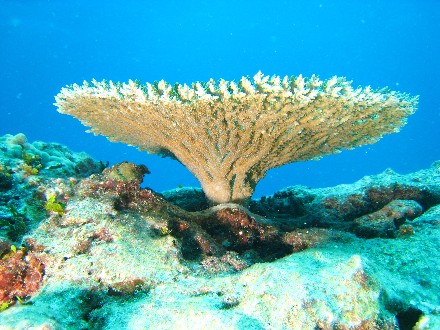At this point, most people are aware of how important the coral reefs are to the world’s oceans and the world itself. With this knowledge, you would think that we would show more respect to this fragile environment. However, this is not the case, specifically in the Indo-Pacific region. This area is infamous for their destructive fishing techniques, using cyanide and dynamite to collect stunned fish. The use of cyanide has been banned for quite sometime, but is still being used by some to collect fish for the aquarium hobby. Cyanide fishing can damage or kill corals that are exposed during the catching process, not to mention that the fish that it was intended will most likely die days or weeks down the road. Blast fishing is just as bad if not worse, a battle that has been fought for decades.
Blast fishing has decreased in recent years, but still remains a problem. This technique is very simple; using a homemade bomb, a diver detonates the bomb in a school of fish, stunning and/or killing them. This makes the dead and stunned fish easy pickings. This technique began shortly after WWII, with no regulation. One can only imagine the amount of damage that has occurred between then and now. Corals and any fish in the blast zone are killed almost immediately.
There was recently a study that was just published in the Journal Conservation Letters, looking at the cost of rebuilding after blasting versus the cost of prevention of the practice. Researchers looked at a specific region called Komodo National Park, south of the main island of Indonesia. This region has been devastated by blast fishing, it is reported that by the mid 90s, over half of the area’s coral reefs were damaged. This area is a very important area, it is also known as the Coral Triangle. Nearly 75% of the world’s coral species are found in the region, along with 40% of coral reef fish, and 6 of 7 marine turtle species. In the mid 90s, conservation groups such as the Nature Conservancy began guarding the area against blast fishing. The constant policing of the waters has decreased the blast fishing 80% to 100%. If local divers and fishermen witness suspicious activity, they report it to the local authorities. The problem is the cost of this type of protection, especially in such vast areas.
 Cleanup and reef restoration operations in damaged areas has also been going on for years. These are very involved and costly processes. Artificial reefs are made out of quarried rock and/or concrete structures. It is estimated that the costs per acre to rehabilitate could range from $10,000 to as much as $247 million per acre depending on the location. In Komodo National Park alone, it is estimated that it would cost as much as $40.8 million to install rock piles and rehabilitate the region. Wouldn’t it be easier to just prevent the destruction in the first place? The estimated cost to patrol the park over a seven year period is around $1.12 million dollars. There really shouldn’t be any debate as to what to do. We can rebuild the reefs, but that doesn’t mean all of the fish are coming back, and if they do it will likely take years. The same for the corals, only longer. The biodiversity lost when the reef was destroyed may take decades or longer if it ever fully recovers. The future of the hobby and industry may depend in large part to the steps being taken in the Indo-Pacfic.
Cleanup and reef restoration operations in damaged areas has also been going on for years. These are very involved and costly processes. Artificial reefs are made out of quarried rock and/or concrete structures. It is estimated that the costs per acre to rehabilitate could range from $10,000 to as much as $247 million per acre depending on the location. In Komodo National Park alone, it is estimated that it would cost as much as $40.8 million to install rock piles and rehabilitate the region. Wouldn’t it be easier to just prevent the destruction in the first place? The estimated cost to patrol the park over a seven year period is around $1.12 million dollars. There really shouldn’t be any debate as to what to do. We can rebuild the reefs, but that doesn’t mean all of the fish are coming back, and if they do it will likely take years. The same for the corals, only longer. The biodiversity lost when the reef was destroyed may take decades or longer if it ever fully recovers. The future of the hobby and industry may depend in large part to the steps being taken in the Indo-Pacfic.
 That Fish Blog – Aquarium Advice and Information
That Fish Blog – Aquarium Advice and Information



Oh man! Blast fishing shouldn’t be allowed! It kills the corals and a lot of marine habitat.